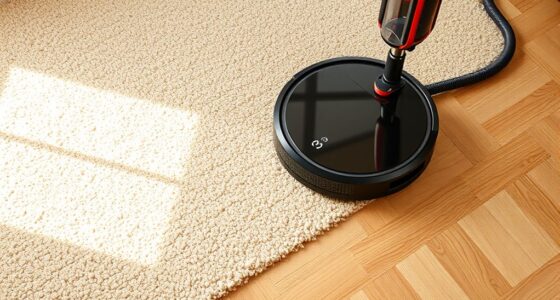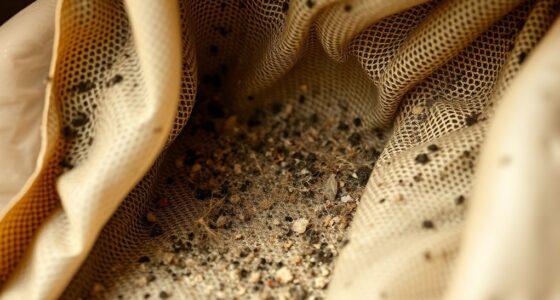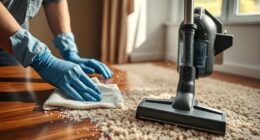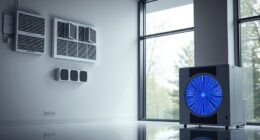Using sensors to monitor indoor air quality helps you maintain a healthier and more sustainable environment. These devices detect pollutants, VOCs, humidity, and CO2 in real time, allowing you to act proactively. They enable smarter ventilation, reduce energy use, and support eco-friendly practices. With the right sensors, you can optimize indoor conditions and cut down on waste. To discover how integrating these technologies transforms your space, explore further options for managing IAQ effectively.
Key Takeaways
- Sensors detect pollutants, VOCs, humidity, and CO2 levels to provide accurate, real-time indoor air quality data.
- Continuous monitoring enables proactive interventions like ventilation or air purifiers to maintain safe environments.
- Data-driven insights optimize HVAC systems, reducing energy use and lowering carbon footprints.
- Easy-to-install sensors integrate with smart homes, offering accessible solutions for sustainable IAQ management.
- Real-time alerts promote quick responses, supporting healthier, more sustainable indoor spaces.

Have you ever wondered how clean the air is inside your home or workplace? It’s easy to overlook the importance of indoor air quality, especially when you’re busy with daily routines. But understanding and maintaining good air quality is essential for your health, comfort, and productivity. That’s where sensor technology comes into play. Modern sensors are revolutionizing how we monitor indoor environments, giving you real-time insights into air quality levels right at your fingertips.
Sensor technology allows you to detect pollutants, volatile organic compounds (VOCs), humidity, and carbon dioxide with remarkable accuracy. These sensors are small, unobtrusive devices that can be installed discreetly in various parts of your home or office. Once in place, they continuously gather data about your indoor air quality, providing a clear picture of what’s happening in real time. This constant monitoring helps you identify sources of pollution, such as cooking fumes, cleaning products, or outdoor air infiltration, before they become health hazards.
Using sensors to monitor IAQ doesn’t just mean reacting to problems; it empowers you to take proactive steps. Many sensor systems connect to your smartphone or home automation setup, alerting you instantly if air quality drops below healthy thresholds. For example, if levels of CO2 or VOCs spike, you might receive a notification prompting you to increase ventilation or activate an air purifier. This immediate feedback allows you to respond swiftly, ensuring that your indoor environment remains safe and comfortable.
Furthermore, sensor technology plays a crucial role in creating sustainable indoor environments. By continuously tracking air quality, you can optimize ventilation systems and reduce energy consumption. Instead of running HVAC systems at full capacity all the time, sensors help you operate them only when necessary. This targeted approach not only saves energy but also reduces your carbon footprint, aligning with eco-friendly practices.
Investing in IAQ sensors is a smart move, especially as awareness around indoor pollutants grows. They’re accessible, easy to install, and compatible with various smart home systems. With precise data, you gain control, making it easier to maintain a healthy indoor environment. Over time, the insights provided by these sensors can help you develop better habits, such as improving air circulation or choosing lower-emission products, further enhancing your indoor air quality.
In essence, sensor technology transforms how you monitor and manage indoor air quality. It shifts the focus from guesswork to data-driven decisions, fostering healthier, more sustainable indoor spaces. By integrating these smart tools into your environment, you’re taking a significant step toward safeguarding your health and contributing to a greener, more sustainable future. Understanding the importance of indoor air quality can help motivate you to implement these innovative solutions.
Frequently Asked Questions
How Often Should IAQ Sensors Be Calibrated?
You should calibrate IAQ sensors at least every six months to address sensor drift and make certain of accurate readings. Regular calibration helps detect and correct sensor drift, maintaining reliable data for your indoor environment. Keep an eye on manufacturer recommendations, as some sensors may require more frequent calibration, especially in high-usage or harsh conditions. Consistent calibration guarantees your IAQ monitoring remains precise and effective for a healthier indoor space.
What Are the Costs Associated With Sensor Installation?
You’ll find that sensor installation costs vary based on the type and number of sensors you need, along with labor expenses. Expect to pay sensor procurement expenses upfront for quality devices, which can range from a few hundred to several thousand dollars. Additional costs may include calibration, maintenance, and integration into your existing system. Budgeting for these expenses helps guarantee your indoor air quality monitoring remains effective and sustainable.
Can Sensors Detect All Indoor Air Pollutants?
You might worry sensors catch every pollutant, but they have limitations. While sensors excel at detecting common pollutants like VOCs or CO2, their specificity varies, so they can’t identify all indoor air contaminants. Sensor limitations mean some pollutants, especially those in trace amounts or complex mixtures, may go unnoticed. Rely on a combination of sensors and expert assessments to truly guarantee a healthy, safe indoor environment.
How Do Sensors Perform in Extreme Temperature Conditions?
Sensors can struggle in extreme temperatures, affecting their durability and accuracy. To maintain performance, you should look for sensors with built-in temperature compensation features, which adjust readings for temperature fluctuations. Additionally, choose sensors designed for high or low-temperature environments to guarantee long-term durability. Proper calibration and protective housings also help sensors operate reliably in challenging conditions, ensuring you get consistent IAQ monitoring regardless of temperature extremes.
What Maintenance Is Required for Long-Term Sensor Accuracy?
You need to regularly calibrate your sensors to maintain accuracy over their lifespan. Typically, calibration should be done every six months or as recommended by the manufacturer. Keep an eye on sensor performance indicators and perform routine cleaning to prevent dust or debris buildup. This proactive maintenance guarantees your sensors stay reliable, prolongs their lifespan, and provides consistent indoor air quality data for a healthier environment.
Conclusion
By embracing sensor technology, you’re opening a window to a healthier, more sustainable indoor world. Think of these sensors as your vigilant guardians, constantly whispering secrets about your air quality. With every reading, you’re steering your environment toward harmony, like a skilled conductor guiding an orchestra. So, stay attentive and proactive—because when you monitor IAQ, you’re planting the seeds for a gasp of fresh, clean air that nurtures both your space and well-being.









